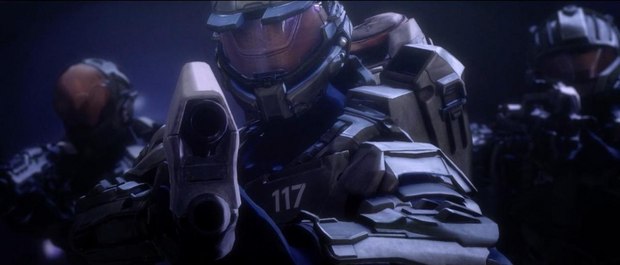A fully animated ‘Halo’ film adaption brings Master Chief and Spartan origins to the screen.
Some would say that the Halo franchise is overdue for a film adaptation. The pieces are there: epic science fiction scope, established fanbase, recognizable and iconic protagonist. A few live-action adaptations have already been done: Halo: Forward Unto Dawn 2012, Halo: Nightfall 2014 – produced by Ridley Scott - and the Neil Blomkamp (District 9 and Chappie) directed promotional Halo 3 video back in 2007. Now, we have a fully animated entry; the latest Halo film is based on the 2001 Halo: The Fall of Reach. One of the first video game novelizations, The Fall of Reach details the origins of the main protagonist, The Master Chief, and how he came to be the last Spartan at the start of Halo: Combat Evolved.
The film starts off, oddly enough with Blue Team from the recently released Halo 5: Guardians. The framing device is that Master Chief and his other Spartan friends (retconned into the rest of the Halo Extended Universe), are on the planet Reach after the alien enemy – The Covenant – has glassed it. Glassing is a process in which the technologically advanced aliens shoot super-powered lasers and burn a planet to a cinder.
One of the first things immediately apparent is the animation style. Sequence, the studio responsible for collaborating with 343 Industries on the previous Halo games, has created the art style and produced the animation for Halo: The Fall of Reach. Sequence’s role in the previous Halo games was delivering a string of stories in what were called Terminals – items that the player would find throughout the game that would tell a story outside of killing aliens and monsters. And while the art style is beautiful with luscious water color aesthetics, the animation is stilted. When any of the characters are running or even walking, you can visualize a rod in their back keeping them upright. It makes moments – like children being replaced with deteriorating clones – slightly comical.
Much of the Halo: The Fall of Reach hour long runtime is about children being taken from their families and trained to be super-soldiers called Spartans. They are taught what it means to be a Spartan as well as what it means to function as a unit. One scene, carried over from the novel, tasks the young Master Chief with reaching the end of the course for a reward of a hot meal – the holiest of rewards in boot camp. When he completes the course, he is told that he has failed and that every other recruit will eat except him. This carries over into the Master Chief we know from the video games where he has his list of allies and will not turn away when they need him.
The second half of the film is about the teenage/adult soldiers becoming acclimated to their MJOLNIR Spartan armor. The Spartan armor is a new and advanced piece of technology that requires a life-threatening surgery to don. It is terrifying to watch as scores of children die while undergoing the surgeries. Some are left brain dead while others become quadriplegics. After surgery, the Master Chief is shown as more emotionally unstable than he was in the novel. During his fight with the Orbital Drop Shock Troopers (ODSTs), he savagely beats the normal troopers with his genetically enhanced fists and muscles. In the novel, he only attacks them when he himself is attacked. One character’s narration reinforces the idea that Master Chief is a loose cannon because of his newfound abilities, while in the novel, he’s portrayed as the opposite.
For the most part, Halo: The Fall of Reach is true to the prequel novelization. Some changes range from the innocuous to the curiously perplexing. Jorge from 2010’s Halo: Reach makes a cameo appearance, seen disagreeing with a drill sergeant on the pronunciation of his name. There is a numerical inconstancy with the number of dead vs. survivors during boot camp as well as the number of surgical survivors. There are also the retcons of adding the members of Blue Team from Halo 5: Guardians into segments of Halo: The Fall of Reach that they were not previously in. These are minor nitpicks in a true to form adaptation.
One of the best additions to Halo: The Fall of Reach is the score. The Tom Salta soundtrack carries the film from scene-to-scene. The classic Halo theme makes appearances here and there but the soundtrack knows when and where to emphasize the emotional gravitas.
One of the more unfavorable aspects of Halo: The Fall of Reach is its abrupt end. Just as the Master Chief and other troopers begin their journey as fully-fledged Spartans, the film ends without warning. It cuts back to the framing story that is largely unnecessary and is just used to advertise Halo 5: Guardians. The animated film adaptation of Frank Miller’s graphic novel, The Dark Knight Returns, was split into two parts for a full three-hour film, but had the good sense to indicate to the viewer that the story would be continued in a later episode. Here, the end comes so suddenly, that you’re left frustrated that the visualization of a critically lauded novel would end before the novel’s story concludes.
Halo: The Fall of Reach, like the novelization it is based on, stands to achieve the same audience impact. Once the second part of the animated adaptation is released, we may see more game novelizations adapted into films. With just a few missteps, Halo: The Fall of Reach makes important strides towards a more accessible Halo universe and lore, bringing the franchise to a wider audience than the games and books have ever reached.
--
Spencer Fawcett is a screenwriter who also does production work for NBC/Universal. He has written for Parade Magazine and ASUs The State Press. Twitter: Whizbang813









